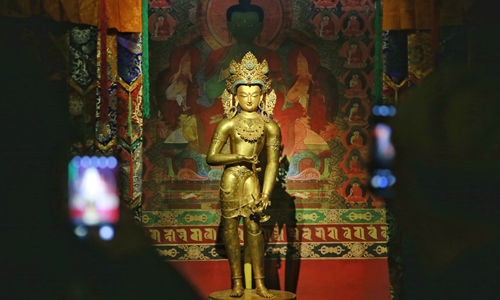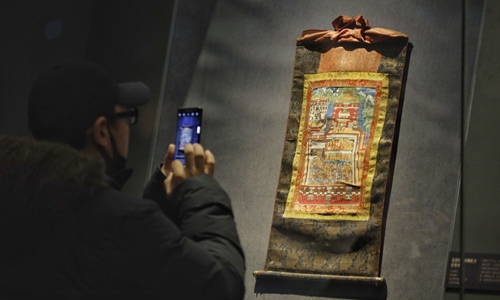HOME >> ARTS
Exhibition displaying relics from Tashi Lhunpo Monastery debuts in Beijing
By Liu Zhongyin Source:Global Times Published: 2019/12/10 23:20:14

Maitreya Bodhisattva statue Photo: Li Hao/GT
An exhibition titled "The Fortune and Longevity of Sumeru: An Encounter between the Tashi Lhunpo Monastery and the Palace Museum" opened at the Palace Museum on Tuesday and will run until February 29, 2020.
Tashi Lhumpo Monastery is one of the sacred sites of Tibetan Buddhism's Gelug Sect and literally means "the auspicious Sumeru monastery." Founded in 1447 by a disciple of the Gelug Sect, Tashi Lhumpo Monastery has been overseen by Panchen Lamas (Panchen is a title meaning "scholar") since the early 17th century.
The fifth Panchen Lama was appointed and given the title of Panchen Erdeni by Emperor Kangxi in 1713. The emperor sent symbolic gold plates and gold seals to the Panchen Lama. This close relationship fostered a remarkable exchange of cultural relics between Tashi Lhunpo Monastery and the Forbidden City.
The exhibition features 280 items from both Tashi Lhunpo Monastery and the Palace Museum, including Tibetan Buddhist relics, official documental objects and some exquisite artifacts sent to Panchen Lamas as imperial favors.

A visitor takes a photo of an item at the exhibition in the Palace Museum on Tuesday. Photo: Li Hao/GT
Dozens of precious Thangka, a kind of scroll painting mounted on satin or other fabrics, are on display. Tashi Lhunpo Monastery is an important painting center in the Gtsang area (Houzang in Chinese) and a center for the Miantang style in making Thangka. Using dyes extracted from natural resources, Thangka usually have bright and vivid colors. The exhibited Thangka are from both Tashi Lhunpo Monastery and the Palace Museum.
One prominent statue is a 180-centimeter-tall solid copper Maitreya Bodhisattva in a distinctive Nepalese style. It was a masterpiece made by Tashi Lhunpo Monastery's official workshop in the 18th century and is decorated with gem stones. Such statues are rare in Tibet.
The gold seal bestowed to the fifth Panchen Lama by Emperor Kangxi is also on display at the exhibition. It is inscribed with the languages of three different ethnic groups - the Han, Manchu and Tibetan people - which shows recognition both religiously and politically.
One blue glass vase in the shape of a trophy-like gu, an ancient Chinese wine cup also used as a ritual vessel, is particularly attractive and there are other exquisite glass items made in royal kilns.
Apart from artifacts, there are also introductions to the lives and significance of all the appointed Panchen Lamas. This is the first time that the Palace Museum has held an exhibition on the theme of Panchen Lamas and Buddhist arts in a royal court.
It is also the first time that relics from Tashi Lhunpo Monastery have been taken to be put on display in a museum. The exhibition also marks the start of a series of activities to commemorate the 600th anniversary of the Forbidden City.
Posted in: CULTURE & LEISURE